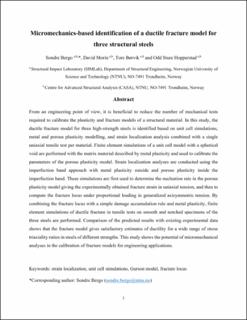| dc.contributor.author | Bergo, Sondre | |
| dc.contributor.author | Morin, David | |
| dc.contributor.author | Børvik, Tore | |
| dc.contributor.author | Hopperstad, Odd Sture | |
| dc.date.accessioned | 2021-10-15T07:00:04Z | |
| dc.date.available | 2021-10-15T07:00:04Z | |
| dc.date.created | 2020-01-13T12:13:10Z | |
| dc.date.issued | 2020 | |
| dc.identifier.citation | Engineering Fracture Mechanics. 2020, 224 (106803), 1-16. | en_US |
| dc.identifier.issn | 0013-7944 | |
| dc.identifier.uri | https://hdl.handle.net/11250/2823166 | |
| dc.description.abstract | From an engineering point of view, it is beneficial to reduce the number of mechanical tests required to calibrate the plasticity and fracture models of a structural material. In this study, the ductile fracture model for three high-strength steels is identified based on unit cell simulations, metal and porous plasticity modelling, and strain localization analysis combined with a single uniaxial tensile test per material. Finite element simulations of a unit cell model with a spherical void are performed with the matrix material described by metal plasticity and used to calibrate the parameters of the porous plasticity model. Strain localization analyses are conducted using the imperfection band approach with metal plasticity outside and porous plasticity inside the imperfection band. These simulations are first used to determine the nucleation rate in the porous plasticity model giving the experimentally obtained fracture strain in uniaxial tension, and then to compute the fracture locus under proportional loading in generalized axisymmetric tension. By combining the fracture locus with a simple damage accumulation rule and metal plasticity, finite element simulations of ductile fracture in tensile tests on smooth and notched specimens of the three steels are performed. Comparison of the predicted results with existing experimental data shows that the fracture model gives satisfactory estimates of ductility for a wide range of stress triaxiality ratios in steels of different strengths. This study shows the potential of micromechanical analyses in the calibration of fracture models for engineering applications. | en_US |
| dc.language.iso | eng | en_US |
| dc.publisher | Elsevier | en_US |
| dc.title | Micromechanics-based identification of a ductile fracture model for three structural steels | en_US |
| dc.type | Journal article | en_US |
| dc.description.version | submittedVersion | en_US |
| dc.rights.holder | This is the authors' manuscript to an article published by Elsevier. | en_US |
| dc.source.pagenumber | 1-16 | en_US |
| dc.source.volume | 224 | en_US |
| dc.source.journal | Engineering Fracture Mechanics | en_US |
| dc.source.issue | 106803 | en_US |
| dc.identifier.doi | 10.1016/j.engfracmech.2019.106803 | |
| dc.identifier.cristin | 1771312 | |
| dc.relation.project | Norges forskningsråd: 237885 | en_US |
| cristin.ispublished | true | |
| cristin.fulltext | preprint | |
| cristin.qualitycode | 1 | |
